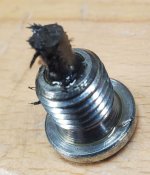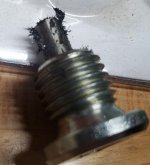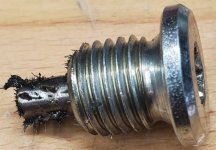I've been talking to a few of our local 'Engine Manufacturing Engineers' since my last post in this thread, and they reminded me that
this is one time when it REALLY CAN HURT to change the oil too early!! :yikes:
Beyond Slider's post, they stressed that other thing to remember about
WHY IT'S SO IMPORTANT to leave your 'initial oil change' in the engine until it's scheduled change time is that while that 'first run & oil change in the manufacturing plant' that should address any FOD issues has
almost always ALREADY BEEN DONE,
the next oil change period is pretty much ESSENTIAL to the proper bedding in of your new engine's rings & bearings, valves, valve guides, etc etc!! :lecturef_smilie:
That initial service period specified by the manufacturer has been calculated based upon the rate at which the 'as sold' oil fill collects all the microscopic contaminants & debris generated and then effectively shears down - so by replacing that oil early and putting in fresh oil that hasn't yet lost any viscosity/shear qualities or collected the microscopic bits that are essential for the proper bedding in of all those fairly important components, you are quite possibly (if not actually
very likely!

) messing with their effective bedding in, and therefore you are quite likely harming your engine's potential life &/or performance, power output, & maybe even fuel economy, even if you don't ever recognise that because you'll never actually get to experience its full potential because you stuffed any chance of ever experiencing that full potential by changing the oil out
TOO EARLY!! :shocked:
Still, as I said earlier, you've paid for it, so it's your engine, and you can do/throw whatever at it you feel like. However, it might pay to remember that there's usually a few reasons for those 'recommended oil change periods', and especially for the first one, leaving the 'as sold' oil fill in for that length of time is quite important to achieving the full potential of the engine as part of its 'bedding in' process, even if we don't actually need to use special 'running in oils' &/or do too much in the way of 'babying' the engine &/or driveline these days!! :thumbup:
Good Luck! :cheers:
PS:
Oh, and those previously mentioned Engineers also suggested that you should expect to see
at least some fine metal debris (but hopefully not any chunks much larger than a fingernail cutting!

) collected by the magnet on the drain plug when you
do (in the recommended course of time/distance travelled) get around to doing that initial oil change, cos that is evidence that your engine internals
HAVE actually done what they need to do during that 'bedding in' process!! If there's
NO sign of any of that metallic 'fur', then they suggested you may not have worked your engine hard enough to have done the 'bedding in' properly, or maybe you've just changed the oil out too early & it's
still bedding in... or glazing in! :gaah:
Just Sayin'




